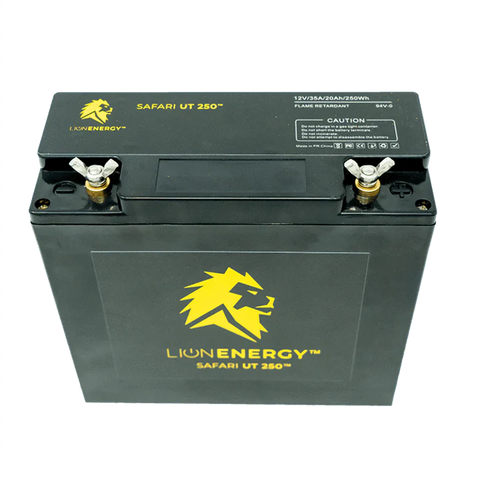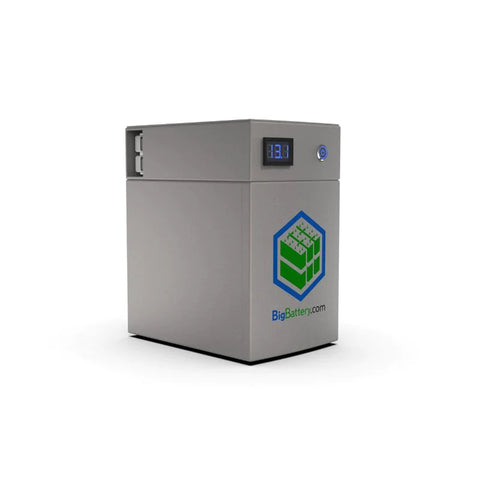
This page was last reviewed: April 21, 2025
We strive to keep all information accurate and up-to-date to help you make informed decisions.
Deep Cycle Battery Voltage Chart
Short on Time? Here’s The Article Summary
The article discusses the importance and characteristics of deep-cycle batteries in the context of solar power systems. It explains that deep-cycle batteries are designed to discharge slowly to a low state of charge and then recharge, unlike standard lead-acid batteries that provide high energy for short periods. The construction and quality of deep-cycle batteries help prevent degradation of the plates, which is common in lead-acid batteries, leading to longer lifespan and better performance.
The article also covers different types of deep-cycle batteries, such as rolled spiral plates, lead tubes with active paste, gel lead acid batteries, and absorbed glass mat (AGM) batteries, each with its advantages. It provides voltage charts for 12V, 24V, and 48V deep-cycle AGM batteries, showing the relationship between voltage and capacity at different charge levels. It concludes by advising on choosing the right deep-cycle battery based on budget and purpose, highlighting AGM batteries as a good starting point for solar applications.
Introduction
Deep cycle batteries are arguably one of the most used batteries in the world of solar, and there are reasons backing their rise in sales.
When we look at values and data, it gives a more visual representation of how the battery performs along with relationships between data.
Let’s look at the different deep-cycle battery voltage charts and dive into what makes these batteries so good.
Table of Contents
What Is a Deep-Cycle Battery?
When putting a deep cycle battery alongside your standard lead acid battery, you may not be able to differentiate them from each other solely based on looks.

However, if you’re in a store and see the two batteries, the deep cycle will be significantly pricier.
Deep Cycle refers to batteries that can discharge slowly to a low state of charge and then recharge again.
When we refer to these batteries charging and discharging, they are known as charge cycles.
So if we’re looking at a 6V battery state of charge chart, the data will show the battery’s capacity when charging and discharging after every cycle.
The greater the discharge, the deeper the cycle.
Difference Between Lead-Acid and Deep-Cycle Batteries
The standard lead acid battery can provide high amounts of energy for a short period.
The deep Cycle on the other hand provides low levels of energy over longer periods, lasting several hours as opposed to 30 minutes.
The construction of a deep cycle battery and the quality you’re getting explains the price tag.
Deep Cycle batteries are still lead acid, so they still use lead-based plates but they don’t suffer the same problem as lead acid batteries.
When lead acid batteries are connected to an appliance, the chemical reaction causes a push and pull between the plates.

This causes the plates to lose their shape, destroying the active paste and decreasing the battery’s performance and lifespan.
Deep Cycle batteries are designed to prevent this from happening or reduce its frequency.
This means when you look at a standard 12V lead acid battery discharge curve or chart and compare it to a deep cycle battery of the same voltage, the results are more pleasing in the latter.
Types of Deep Cycle Batteries
The first type is rolled spiral plates, making it harder for the lead to buckle and degrade after every charge. These plates are made from pure lead and the battery itself has a cylindrical shape.
The second type uses tiny tubes of lead with active paste placed inside, meaning that the paste can’t leak or flake. The tube design also helps reduce the plates from buckling.
The third type uses a silicon gel electrolyte between the plates. This is what we call a gel lead acid battery.
The final type uses a strong barrier to hold the paste to the plates and keeps them in place.
This barrier is made of an electrolyte-soaked glass material that helps the plates maintain their shape.
It also stops the active paste from degrading off the plates. We call this an Absorbed Glass Mat deep cycle battery. These batteries are what we’re testing in our deep cycle battery chart.
12V Deep Cycle AGM Battery Voltage Chart
Let’s have a look at a deep cycle 12v AGM battery charging voltage chart and see the relationship between the values.

A 12V AGM battery's state of charge voltage ranges from 13.0V at 100% capacity to 10.50V at 0% capacity when seen in the context of the 12V AGM battery voltage chart.
For example, you may discover that this 12V Deep Cycle AGM battery still has 70% capacity if you monitor the 12.30V voltage on it.
|
Voltage |
Capacity |
|
13.00V |
100% (charging) |
|
12.80V |
99% |
|
12.75V |
90% |
|
12.50V |
80% |
|
12.30V |
70% |
|
12.15V |
60% |
|
12.05V |
50% |
|
11.95V |
40% |
|
11.81V |
30% |
|
11.66V |
20% |
|
11.51V |
10% |
|
10.50V |
0% |
24V Deep-Cycle AGM Battery Voltage Charge
With this higher voltage 24V deep cycle battery, the voltage varies from 26.00V at 100% charge to 21.00V at 0% charge as shown in the AGM 24V Lead acid battery voltage chart below.

A full battery has a voltage differential of 5.00V from an empty battery.
This figure shows that a 24V battery voltage chart displaying that 20% to 30% charge is left if the voltage difference between the cathode and anode of an AGM battery is measured to be 23.50V using a voltage meter.
|
Voltage |
Capacity |
|
26.00V |
100% (charging) |
|
25.75V |
99% |
|
25.55V |
90% |
|
25.00V |
80% |
|
24.60V |
70% |
|
24.30V |
60% |
|
24.10V |
50% |
|
23.90V |
40% |
|
23.62V |
30% |
|
23.32V |
20% |
|
23.02V |
10% |
|
21.00V |
0% |
48V Deep-Cycle AGM Battery Chart
A high voltage 48V deep cycle AGM battery has a voltage range of 52.00V at 100% charge to 42.00V at 0% charge.

A full battery has a 10.00V absolute voltage difference from an empty battery.
This chart indicates that this 48V battery still has 20% to 30% charge left if the voltage difference between the cathode and anode of an AGM battery is measured to be 47.00V using a voltage meter.
|
Voltage |
Capacity |
|
52.00V |
100% (charging) |
|
51.45V |
99% |
|
51.10V |
90% |
|
50.00V |
80% |
|
49.20V |
70% |
|
48.60V |
60% |
|
48.20V |
50% |
|
47.80V |
40% |
|
47.24V |
30% |
|
46.64V |
20% |
|
46.04V |
10% |
|
42.00V |
0% |
Deep-Cycle Battery Discharge Chart
If you’re looking to use a deep cycle battery in your solar system, its capacity to discharge deeply without causing any harm to the plates is unquestionably advantageous.
Discharge and charge are frequently represented using curves and charts.
To comprehend it, we must consider the discharge's depth. This is the maximum amount of power a battery can supply.
If you have a deep cycle battery with a depth of discharge of 35%, the load can only use 35% of the battery's capacity.
In other words, with a 35% depth of drain, your 400Ah battery can only generate 260Ah.
The battery drains when a load is connected to it because the load draws current from the battery.
The process through which a battery entirely loses its charge is known as battery discharge, and as the load takes more electricity, the battery depletes more quickly.
We can measure batteries using two distinct discharge periods since different batteries are used for various purposes.
You may determine the discharge current for your battery using the battery pack rating in the graph below in the same way that you would use most voltage charts.
Get your battery's Ah rating, then look at the relevant column.
|
Battery or Battery Pack Ah Rating |
7 Minute Maximum Discharge Current |
30 Minute Maximum Discharge Current |
|
5Ah |
15 Amps |
10 Amps |
|
7Ah |
21 Amps |
14 Amps |
|
8Ah |
24 Amps |
16 Amps |
|
9Ah |
27 Amps |
18 Amps |
|
10Ah |
31 Amps |
21 Amps |
|
12Ah |
36 Amps |
24 Amps |
|
14Ah |
42 Amps |
31 Amps |
|
15Ah |
44 Amps |
32 Amps |
|
18Ah |
57 Amps |
40 Amps |
|
22Ah |
66 Amps |
46 Amps |
|
35Ah |
105 Amps |
84 Amps |
AGM Battery Resting Voltage Chart
When a battery is switched off and is fully charged, the battery has reached it’s resting voltage. As soon as you switch the battery on, however, the voltage rises.
A typical deep cycle battery will take anywhere between 12 and 24 hours to reach its resting voltage state.
|
The Capacity of Deep Cycle Battery |
Resting Voltage |
|
12V Battery |
12.85V |
|
24V Battery |
25.85V |
|
48V Battery |
51.70V |
What Deep Cycle Battery to Choose?
Deep cycle batteries are built for lengthy, frequent, and deep charging/discharging cycles so that they can store and transmit the energy produced by renewable sources like solar panels.

When someone speaks about a solar battery, they are simply referring to a deep cycle battery. Car batteries cannot be utilized as solar power batteries due to this.
The choice all comes down to budget and purpose.
You will find that most deep-cycle solar batteries are AGM as they are perfect for those starting in the world of solar.
The other options increase in price and some as the more cylindrical design deep cycle battery work best for smaller applications or projects.
The Ultimate Solar + Storage Blueprint (Mini Course)
Struggling to understand how solar + storage systems actually work? Looking to build or buy your own solar power system one day but not sure what you need? Just looking to learn more about solar, batteries and electricity?
Join 15,000+ solar enthusiasts breaking free from their energy dependence with this short step-by-step video course that will make you a solar + storage expert. Start your journey to energy independence today.
Who is ShopSolar.com?
ShopSolar.com is the #1 digital platform that enables consumers & businesses to source and purchase complete solar + storage solutions direct, saving you thousands in time, energy and money! With over 40,000+ happy customers, we’re on a mission to make solar simple, transparent and affordable.
Did You Find Our Blog Helpful? Then Consider Checking:
- Battery Voltage Chart
- LifePo4 Voltage Chart
- Lithium-Ion Battery Voltage Chart
- Solar Panel Voltage Chart
- 52v Battery Voltage Chart
- AA Battery Voltage Chart
- RV Battery Voltage Chart
- Battle Born Battery Voltage Chart
- 48v Battery Voltage Chart
- Solar Voltage Drop Calculator
- Watts to Volts Calculator
- Convert Volts to Watts
- Amps to Volts Calculator
- Amps, Watts, & Volts Calculator
- Convert Volts to Amps






Comments
Leave a comment